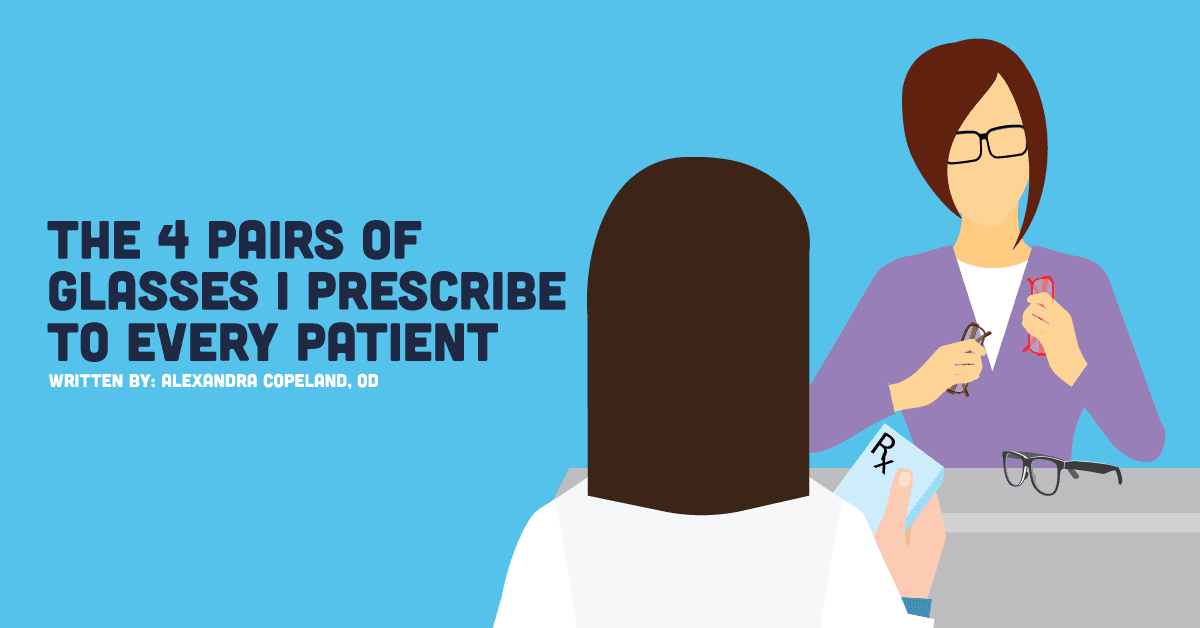These are 4 pairs of glasses I prescribe to every patient.
That sounds like a lot, and it is. While not all patients are created equal, I do find that most patients can benefit from multiple pairs of glasses. Here are the types of glasses I think work well to meet patient need and the glasses I prescribe to many of my patients.
1. Habitual Glasses with Anti-glare Treatment
These are the glasses my patient will be wearing most of the time – their workhorse. Anti-glare treatment has become non-negotiable for me! I extensively educate my patients about the benefits of anti-glare treatment, and how it can really create a better visual experience for them – from working on the computer to driving at night. I have found anti-glare lens treatment to be extremely beneficial in all kinds of situations – especially in the digitally immersed environment so many of us live in. Some anti-glare treatments also come with UV and/or blue light filtering properties – like Crizal Sapphire® 360° UV Lenses or Crizal® Prevencia® to name a few of many options out there. This provides yet another advantage in recommending anti-glare treatment to patients, and for all of these reasons, make up part of those 4 glasses I prescribe so often.
Here is an infographic that highlights many of the different Crizal options.
2. Glasses with Photochromatic Technology
I recommend Transitions® lenses to all my patients. A vast majority of my patients who have worn Transitions lenses in the past, cannot live without them! For my patients who aren’t interested in wearing this type of technology – I make it my job to discover why. I have found that most of the patients in this category have outdated ideas about Transitions lenses or other photochromic lens options out there, recalling how their grandma or grandpa used to look in them.
Essilor recently released new colors and mirror options. Having these additional options has added a customization component that we never had before. I believe this additional customization will help meet the style and fashion demands of the modern millennial. While these lenses provide ultraviolet and harmful blue light filtering properties, I don’t stop there. I make sure to educate patients that Transitions lenses are a convenience lens; they do not take the place of prescription sunglasses – which bring me to number three.
3. Prescription Sunglasses
Again, Transitions lenses are not meant to take the place of sunglasses, and I educate my patients on this. This conversation allows me to segue into a discussion around prescription sunglasses. I tell my patients that if they want the ultimate in ultraviolet light protection and glare reduction – polarized prescription sunglasses are a must!
I particularly recommend this as an option for my patients who spend a lot of time outdoors or partake in sports and outdoor activities like fishing, cycling, and golfing. I always remind patients that sunglasses provide double duty – protecting both their eyes and the sensitive skin around them from UV rays while enhancing their visual clarity and comfort. My patients understand and perceive the value in this and appreciate the recommendation.
Check out this article on why “expensive” sunglasses are worth the extra investment!
4. Hobby Specific Eyewear
I was going to call this category sports specific eyewear, but many patients can benefit from activity specific lenses for hobbies other than sports. For example, does the patient like to partake in a lot of needlework? Recommending near vision only glasses with a slightly stronger add will allow he or she to see fine stitches. Does the patient play sports? Recommending sports goggles will first and foremost keep the eyes protected, but they will also prevent that habitual pair of glasses from breaking!
I’ll also closely examine a patient’s work activities in this category particularly my heavy computer users. I have found that an increasing number of my millennial patients suffer from digital eyestrain – from the demands we place on our eyes by consuming so much digital content both at work and home. I have had great success with Eyezen™+. This patient demographic appreciates the discussion around eye fatigue, and this lens has worked well in my practice to provide these patients with relief from digital eyestrain, protection against harmful blue light, and sharper vision from a digital aspheric design.
Here is an article, video, and infographic that discusses Eyezen+ in depth!
As an added bonus, discussing hobbies and sports activities can also give you the opportunity to recommend daily disposal contacts lenses.
Would the patient like to attend a wedding without his or her glasses? Who wants to have to push up their glasses during yoga? Although dailies are growing in popularity, most non-contact lens wearers have no idea they have the option to be glasses free. Asking patients what they do at work and outside of work also allows you to connect with them on a personal level.
